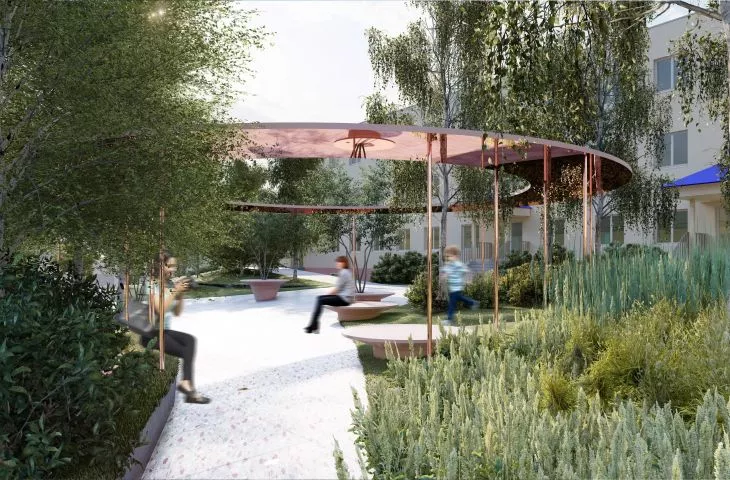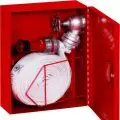In April, the Faculty of Architecture at the Cracow University of Technology, in cooperation with the Mayor of Wieliczka Artur Koziol, held a remote scientific seminar entitled Quality of urban space. A mobility plan for the outpatient clinic in Wieliczka. During the event, a number of student proposals for a new communication layout and development changes at the clinic on Szpunar Street in Wieliczka were presented.
The seminar, held on April 22 this year, began with a speech by Prof. Magdalena Kozien-Wozniak (dean of the Faculty of Architecture at PK), under whose guidance the Cultural Facilities Design Team of the A-6 WA Department of Architectural Design at PK together with sixth-semester students worked on a design task. The goal of this challenging project was to improve the infrastructure at the Wieliczka clinic. Analysis and design were prepared in the teams of Dr. Pawel Zuk, Eliza Owczarek and Marcin Gierbienis.
the seminar was held online
© Cracow University of Technology
The online meeting was attended by the Rector of the Cracow University of Technology Prof. Andrzej Białkiewicz, Mayor Artur Kozioł, Deputy Mayor Piotr Krupa, Director of the Municipal Health Clinic in Wieliczka Grażyna Kozak, Director of the Municipal Road Administration in Wieliczka Teresa Kuchnia and Prof. Tomasz Kozłowski, Head of the Department of Architectural Design A-6 WA PK. Rector Prof. Andrzej Bialkiewicz stressed the importance of the university's contact with the city, as an appropriate form of cooperation, giving valuable results. The successful relationship between the parties was mentioned by the mayor of Wieliczka, for whom last year students had the opportunity to design the Geriatric Care Center and the House of Literature.
Aleksander Kwaśniak proposed a ribbon run along the street
© Aleksander Kwaśniak
outpatient clinic in Wieliczka
The first part of the seminar was about outlining the location situation of the clinic in Wieliczka. When one finds oneself on Szpunar Street, the problems of the existing layout are immediately noticeable. The large number of parked cars impedes pedestrian traffic and the comfort of the surrounding residents. Interestingly, there are still not enough parking spaces. Reconciling the assessments of residents, patients and employees of the health center, was a challenging task.
In this part of the seminar, students presented analyses of both urban planning, architecture and infrastructure of Wieliczka's center. This allowed them to look at the issue in a broader context - paying attention to the location of parking spaces in terms of the entire city, or the availability of public transportation. The conclusions? The appropriation of all space by cars is not the right direction of development. Spaces should be balanced, offering pedestrians attractive places with social value.
Mikolaj Kusior's project was recognized as the most interesting concept
© Mikolaj Kusior
interdepartmental cooperation
Topics related to accessibility in the broadest sense and improvement of infrastructure were elements of the proposals of didacticians and students. Due to the interdisciplinary nature of the task, Dr. Aleksandra Faron of the Faculty of Civil Engineering at PK became the consultant for the design work. In her scientific and research activities she deals with planning and design of transport systems and mobility management. During the seminar, Dr. Faron gave a presentation on how traffic could be improved by introducing a connection between Szpunara Street and Slowackiego Street. She also convinced the audience to implement a mobility plan that would aim to improve the center's accessibility by offering alternatives to cars, correcting their traffic.
The educational part of the project also dealt with pedestrian traffic changes. One part of the study was a survey that was given to the clinic's staff.
Dr. Aleksandra Faron presented theresults of the survey, stating:
The answers to the question make it clear how accustomed we are to the car and fail to see that we can travel in other ways. The answers also show that the elimination of parking spaces is possible - employees of the center will park in other places, thus opening up the possibility of changing the public space in front of the clinic to one that is friendly to residents and pedestrians.
woonerf by Justyna Kopacz
© Justyna Kopacz
The overriding idea was to turn Szpunar Street into a woonerf - a street for living, where the pedestrian has priority and vehicular traffic is calmed down. Thanks to this type of action, the space will gain a new quality - calmed, aesthetically pleasing and focused on ecological solutions and supporting the health of Wieliczka residents - as befits a clinic.
student ideas
Kika week before the seminar, students in groups developed their own mobility plans, and also worked individually on ideas, changing the visual side of the space. The projects took part in a competition, judged by a jury chaired by the mayor of Wieliczka. The six concepts qualified for the competition finals were presented in the second part of the seminar by the authors. Each project involved a different, author's idea of making a woonerf and changing the development of the square in front of the clinic. The unifying theme of the projects was the introduction of greenery. Contact with nature is especially important for patients, and during the pandemic period an attractively designed outdoor space can be a waiting room under a cloud.
Aleksander Kwaśniak's design took a soft, organic form
© Aleksander Kwaśniak
Justyna Kopacz and Aleksander Kwaśniak used soft and organic forms in their ideas, referring to the trendy biophilia trend. The mayor appreciated the aesthetic value of Justyna's design, which, in addition to greenery, relied on an accent of pink, copper color to emphasize the landscaping elements intended for users. A distinctive feature of Aleksander Kwaśniak's concept was the ribbon that ran along the street and through the square, changing from a pedestrian surface into a striking public space.
Renata Kozina, using the form of a circle, separated intimate courtyards
© Renata Kozina
RenataKozina and Eliza Salapat, on the other hand, used yellow as a leitmotif that accompanies the viewer in various parts of the development. Renata's starting point was a circle, which separated the intimate courtyards in the square, while Eliza relied on a square, which she scattered modularly throughout the development.
The square motif runs through Eliza Salapat's design
© Eliza Salapat
Students Jan and Nikolai Kusior proposed bold layouts that changed the existing functioning of the area, introducing cubic elements such as sheds and raised bridges over the area. Their designs featured additional solutions, such as an amphitheater, or an elevator at the end of the street for disabled access.
Jan Kusior proposed bridges raised above the area
© Jan Kusior
The jury, after listening to all the presentations and reviewing the studies, considered the most interesting proposal by Mikolaj Kusior, appreciating the idea of hiding parking spaces in canopies, giving the square space back to residents.
The presentations were followed by a discussion, which was the starting point for further design activities. Students are working on the task until the end of the semester to present a service building located in the frontage of Slowackiego Street in Wieliczka in June.
We encourage you to view the entire gallery and learn more about all the projects.



















































































































































